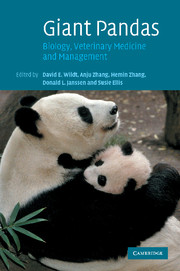Book contents
- Frontmatter
- Contents
- List of contributors
- Foreword
- Acknowledgements
- 1 The giant panda as a social, biological and conservation phenomenon
- 2 The Giant Panda Biomedical Survey: how it began and the value of people working together across cultures and disciplines
- 3 Factors limiting reproductive success in the giant panda as revealed by a Biomedical Survey
- 4 Significant medical issues and biological reference values for giant pandas from the Biomedical Survey
- 5 Life histories and behavioural traits as predictors of breeding status
- 6 Nutrition and dietary husbandry
- 7 Male reproductive biology in giant pandas in breeding programmes in China
- 8 Endocrinology of the giant panda and application of hormone technology to species management
- 9 The value and significance of vaginal cytology
- 10 Parentage assessment among captive giant pandas in China
- 11 The science of behavioural management: creating biologically relevant living environments in captivity
- 12 Evaluating stress and well-being in the giant panda: a system for monitoring
- 13 The neonatal giant panda: hand-rearing and medical management
- 14 Consequences of early rearing on socialization and social competence of the giant panda
- 15 Medical management of captive adult and geriatric giant pandas
- 16 Diseases and pathology of giant pandas
- 17 Ultrasonography to assess and enhance health and reproduction in the giant panda
- 18 Gastrointestinal endoscopy in the giant panda
- 19 Historical perspective of breeding giant pandas ex situ in China and high priorities for the future
- 20 Role and efficiency of artificial insemination and genome resource banking
- 21 Analysis of demographic and genetic trends for developing a captive breeding masterplan for the giant panda
- 22 Partnerships and capacity building for securing giant pandas ex situ and in situ: how zoos are contributing to conservation
- Index
- Plate Section
- References
15 - Medical management of captive adult and geriatric giant pandas
Published online by Cambridge University Press: 09 August 2009
- Frontmatter
- Contents
- List of contributors
- Foreword
- Acknowledgements
- 1 The giant panda as a social, biological and conservation phenomenon
- 2 The Giant Panda Biomedical Survey: how it began and the value of people working together across cultures and disciplines
- 3 Factors limiting reproductive success in the giant panda as revealed by a Biomedical Survey
- 4 Significant medical issues and biological reference values for giant pandas from the Biomedical Survey
- 5 Life histories and behavioural traits as predictors of breeding status
- 6 Nutrition and dietary husbandry
- 7 Male reproductive biology in giant pandas in breeding programmes in China
- 8 Endocrinology of the giant panda and application of hormone technology to species management
- 9 The value and significance of vaginal cytology
- 10 Parentage assessment among captive giant pandas in China
- 11 The science of behavioural management: creating biologically relevant living environments in captivity
- 12 Evaluating stress and well-being in the giant panda: a system for monitoring
- 13 The neonatal giant panda: hand-rearing and medical management
- 14 Consequences of early rearing on socialization and social competence of the giant panda
- 15 Medical management of captive adult and geriatric giant pandas
- 16 Diseases and pathology of giant pandas
- 17 Ultrasonography to assess and enhance health and reproduction in the giant panda
- 18 Gastrointestinal endoscopy in the giant panda
- 19 Historical perspective of breeding giant pandas ex situ in China and high priorities for the future
- 20 Role and efficiency of artificial insemination and genome resource banking
- 21 Analysis of demographic and genetic trends for developing a captive breeding masterplan for the giant panda
- 22 Partnerships and capacity building for securing giant pandas ex situ and in situ: how zoos are contributing to conservation
- Index
- Plate Section
- References
Summary
INTRODUCTION
The medical management of giant pandas has advanced significantly in recent years due to cooperative programmes between Chinese and western institutions, specifically zoos and breeding centres. Key to these partnerships have been veterinarians who have become committed to understanding the diseases affecting this species. Progress has emanated from efforts such as the Biomedical Survey (see Chapter 4) and international personnel exchanges related to giant panda loans to western zoos (see Chapter 22). The result has been many opportunities for veterinarians working with giant pandas to share philosophies, tools, expertise and knowledge which, in turn, have vastly improved medical care of this species in captivity.
There are unique as well as overlapping medical issues impacting the giant panda according to age. For example, Chapter 13 has already addressed health-related topics facing neonates and juveniles. After four years of age, however, the giant panda has matured physically and sexually, leaving behind many of the diseases associated with its youth. Then, after the age of 20 years and during the period of reproductive senescence, another set of potential problems face managers and veterinarians – degenerative changes related to the geriatric condition. Because health and reproduction are improving so rapidly in the ex situ panda population, it is a given that more animals will live longer, requiring more sophisticated veterinary management to ensure well-being for up to 25 years of age or beyond.
This chapter describes the authors' medical experiences with adult and aged giant pandas living in zoos, especially in the USA.
- Type
- Chapter
- Information
- Giant PandasBiology, Veterinary Medicine and Management, pp. 353 - 376Publisher: Cambridge University PressPrint publication year: 2006
References
Accessibility information
- 10
- Cited by

